- 한국어
- English
- 日本語
- 中文
- العربية
- Español
- Français
- Deutsch
- Pусский
- Tiếng Việt
- Indonesian
My first taste of Hanu (한우,Korean beef) was when I visited Wonju. It is near the town of Hoengseong (횡성군), the ultimate source of high quality beef in South Korea. The experience was unforgettable due to the flavor and tenderness. Since then, I’ve been very particular whenever I see a Korean restaurant abroad that claims to serve premium beef. It has to recreate the experience I had back in Korea.
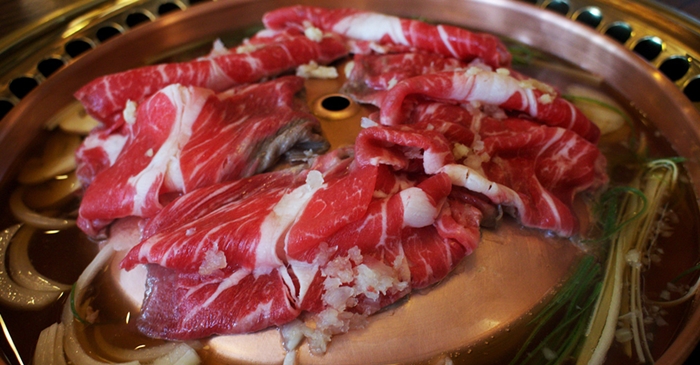
So for first-timers (and even long-time fans of Korean cuisine), how do you know what Korean beef dish to order? I contacted Sariwon Philippines, a restaurant that specializes in providing premium meat selections, to help me refine my taste in beef. I first dined in this place in 2013, when I got intrigued after it was recognized as the Best Korean restaurant by the Philippine Tatler’s Best Restaurants Guide. (A distinction Sariwon achieved again in Tatler’s 2014 list.) Upon searching online, I also found out that it was awarded as the “Best Korean Restaurant” by the Seoul Metropolitan Government.
Now let’s start this Beef 101. The taste of meat is affected by many factors:
Beef part. This determines the tenderness and juiciness of meat.
Beef grade. Usually, the amount of marbling (the white lines you see in your raw beef) is the main determiner of a beef’s quality score. Marbling refers to the amount of intramuscular fat present in the specific beef part. Each country has its own grading system but for the purpose of this article, we will use the one made by the United States Department of Agriculture (USDA.) Other qualities being checked are the meat’s color & firmness and the fat’s color and luster.
Marination. This refers to the length of time a beef has been soaked in seasoned liquid before cooking.
Sauce. The kind of dip prepared should complement the flavor of the cooked beef.
Ideally, the restaurant where you’re dining in should show you the raw meat so that you can appreciate its quality and marbled appearance. After that, the meat is then cooked in front of you.
I got to try SIX (yes, six!) different beef specialties:
Bulgogi (불고기)
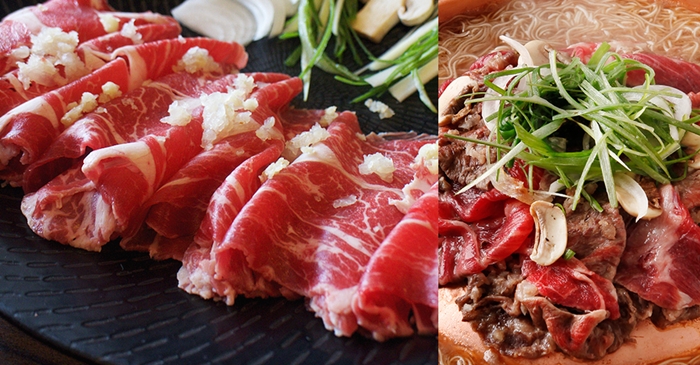
Beef part: USDA Choice Chuck (from the neck, shoulder blade and upper arm of a cow)
Marination: None
Sauce: Sariwon’s special sauce (freshly made from fruits and vegetables including apples, pears, pineapples, onions and celery)
Why should you try it: This is Sariwon’s signature version of bulgogi but you can find a relatively similar one in other restaurants when you say ‘bulgogi jeongol’ (불고기전골, Korean beef noodle hot pot.) The noodles and the beef are cooked together so the juices of the beef are mixed with the broth, giving even more flavor to it. The handmade sweet potato noodles that come with it is also a must-try. Compared to regular flour, sweet potato flour is gluten-free so it’s good for your health. Also, when you find a restaurant that makes their noodles from scratch, you’re assured of a more authentic dining experience.
Seng Galbi (생갈비)
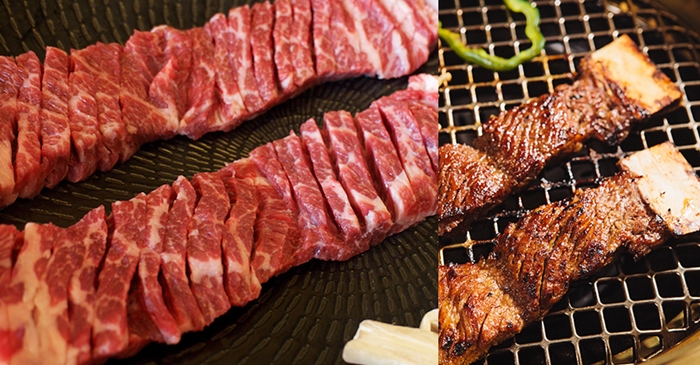
Beef part: USDA Choice Bone in Short Ribs
Marination: None
Sauce: Roasted Korean sea salt and pepper, Korean sesame oil, Tarae (Korean soy sauce & red wine)
Why should you try it: If you want a steak experience the Korean way, then you should go for this. You can either enjoy it as it is or you can wrap it in lettuce or sesame leaf with ssamjang (쌈장, spicy paste) and grilled garlic. Just a tip: take it easy when dipping your beef in the different sauces. Make sure that the flavor of the dip does not come out too strong so as to overshadow the flavor of your seng galbi.
Woo Samgyup (우삼겹)
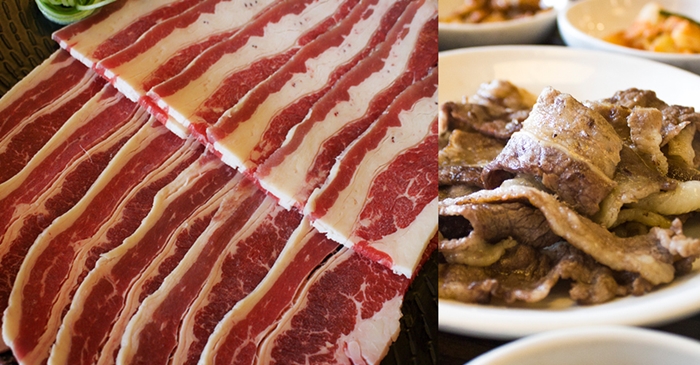
Beef part: USDA Choice Beef Belly
Marination: None
Sauce: Korean soy sauce and mild chili, Korean sesame oil
Why should you try it: A large portion of the taste comes from the marbling that took place. Look how beautiful this meat is! (That’s why I mentioned earlier that you have to see your beef in its uncooked form.) The thin slicing also gives a more tender texture and a more succulent flavor. Remind the staff to have it cooked ‘medium well’ rather than ‘well done’ in order for the beef to fully release the juice and flavor. Slightly dip your beef with the sauces provided, wrap it in lettuce or sesame leaf, then dunk it in your ssamjang saucer before eating the whole thing.
L.A. Galbi (L.A. 갈비)
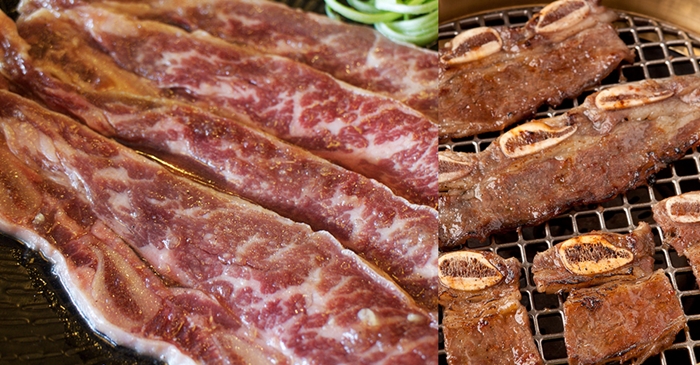
Beef part: USDA Choice Bone in Short Ribs
Marination: Korean sea salt and spices for 24 hours
Sauce: None
Why should you try it: What I like about this beef is the sweet burst of flavor in your mouth as a result of careful marination. I would pair this with steamed rice rather than wrapping it in lettuce. And if you’re wondering why it’s called “L.A.”, it’s because Korean restaurants in Los Angeles, USA have their own way of cutting it (LAteral cut.) You get thinner slices rather than the typical big chunks in South Korea.
Wang Galbi (왕갈비)
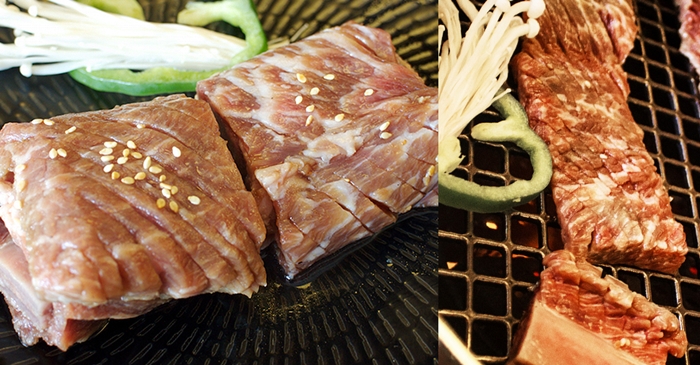
Beef part: USDA Choice Bone in Short Ribs
Marination: Korean soy sauce, fruits, and vegetables such as apples, pears, and onions
Sauce: None
Why should you try it: ‘Wang’ literally means ‘king’ and you’re getting a royal treatment for several reasons: 1) The exclusive cutting technique ensures perfect texture and flavor. L.A. Galbi is sliced across the bones but Wang Galbi is sliced AWAY from the bone so you get a thicker fillet of juicy meat. 2) This is typically served in traditional Korean restaurants so this is authentic Korean-style. 3) The marination process is taken very seriously. The medley of select fruits and vegetables in your taste buds won’t be achieved without rigorous soaking and seasoning of the beef.
Chessangeup Yangnyeom Galbisal (최상급 양념 갈비살)

Beef part: USDA Choice Boneless Short Ribs
Marination: Korean sea salt and spices
Sauce: Roasted Korean sea salt and pepper, Korean sesame oil, Tarae (Korean soy sauce & red wine)
Why should you try it: This is the kind of beef that you want to buy for special occasions like birthdays or anniversaries. If you want a melt-in-your-mouth experience, this beef’s flavor will surely linger in your mouth (and mind!) The name is a bit of a tongue twister – chessangeup (최상급, the highest grade) yangnyeom (양념, seasoned) galbisal (갈비살, rib meat), but after tasting it, you won’t forget its name and meaning EVER.
After knowing some of the common types of Korean beef dishes, which one are you excited to try now?

Quick trivia: Sariwon was established in 1938 in the town of Sariwon, Hwanghae province in North Korea. Bun-Im Koo had a customized Bulgogi recipe for her husband who was then ailing with diabetes. The recipe was special because it didn’t use sugar as a sweetener but instead, a unique fragrant sauce made of 12 kinds of vegetables and fruits gave its beef barbecue that special flavor. Today, Sariwon has 6 branches in Seoul and their first international branch was established in Manila, Philippines back in 2012. Check out Sariwon Philippines' Facebook page for more information.
By Marius Oczon for the Korea Blog